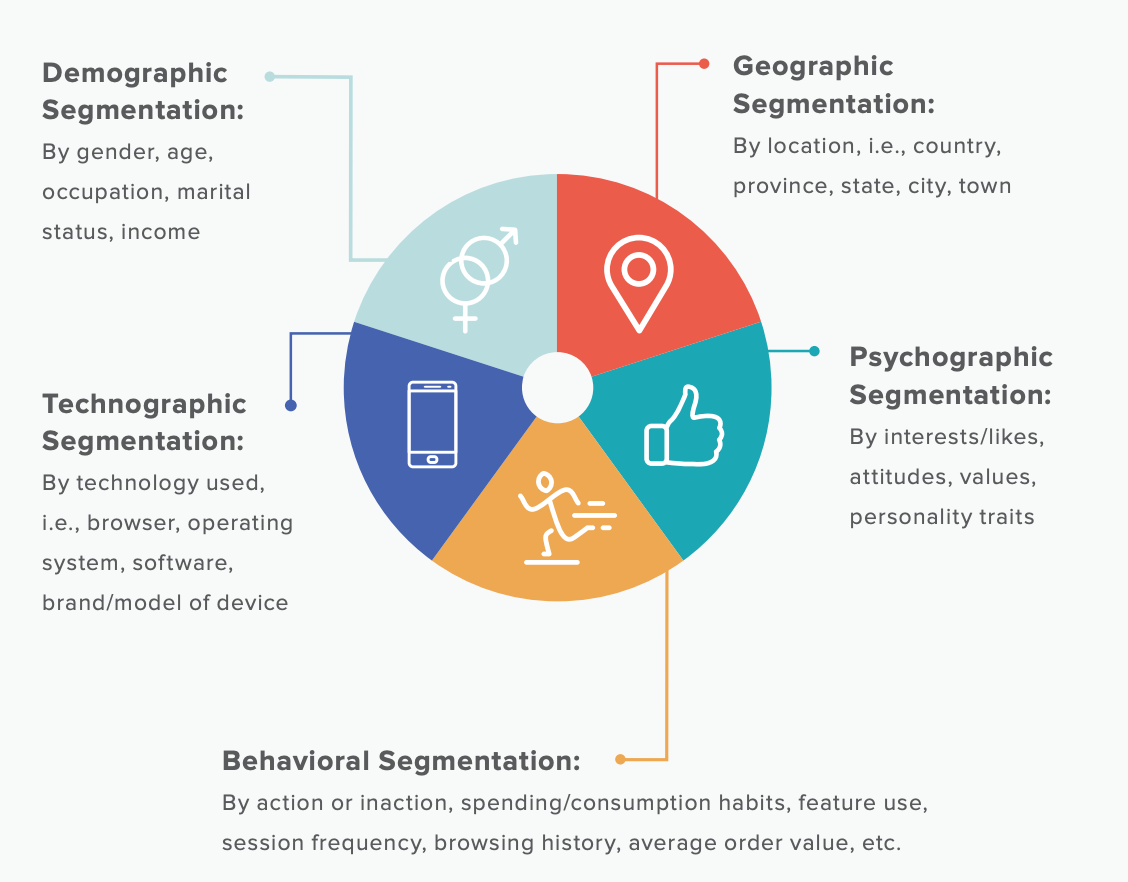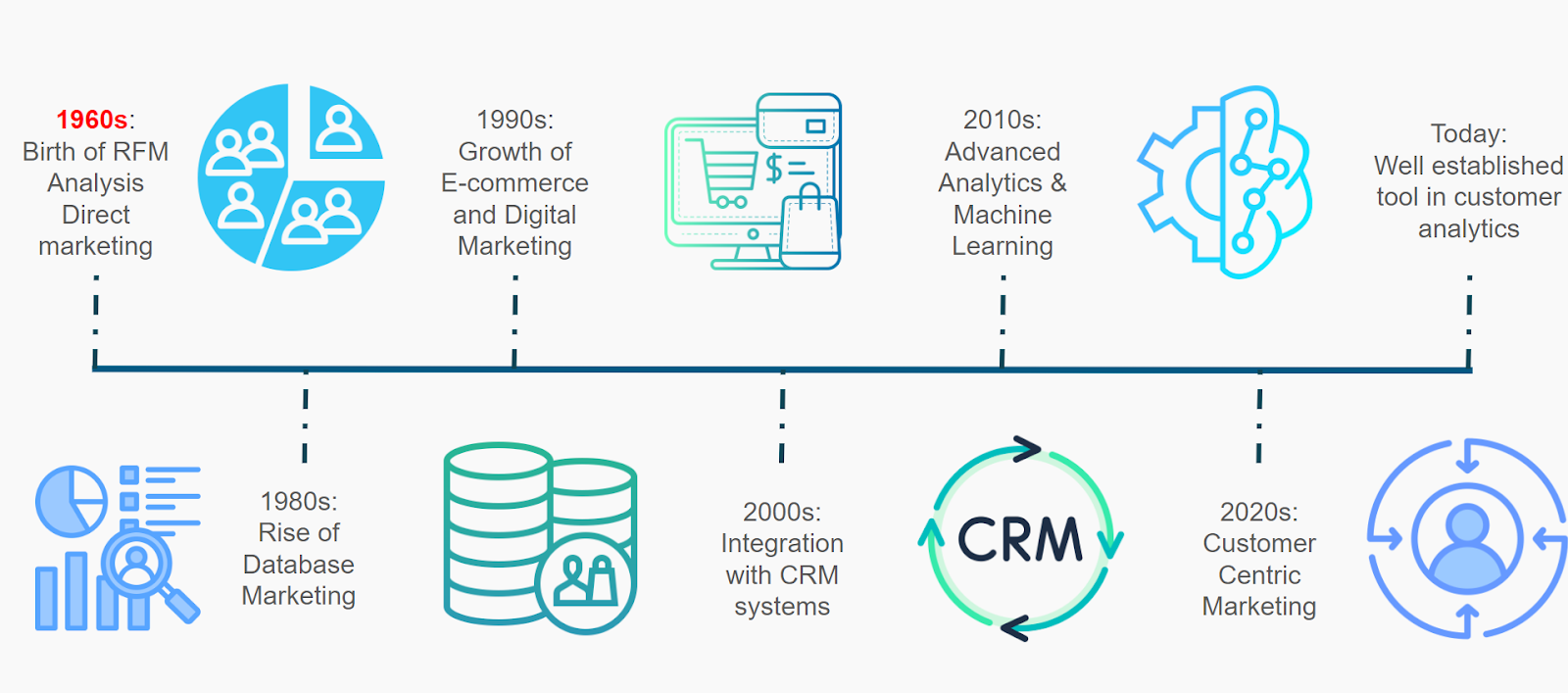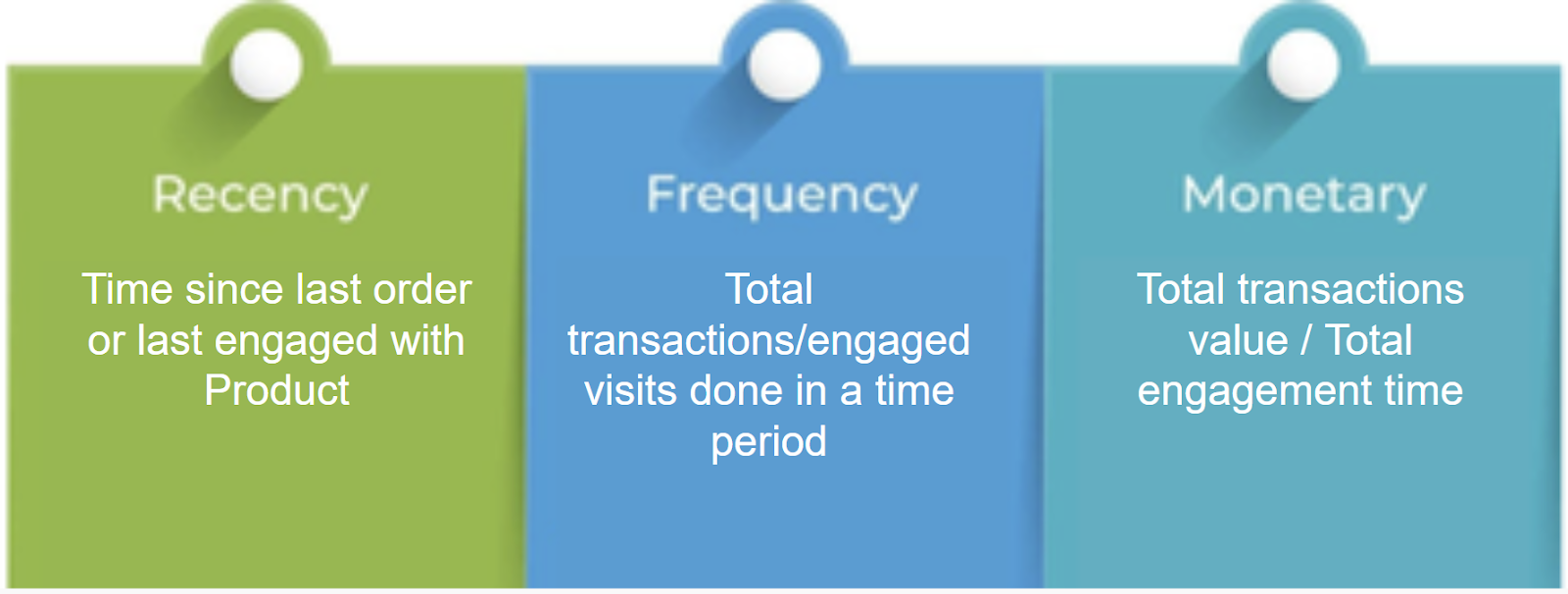To earn the respect (and eventually love) of your customers, you first have to respect those customers. That is why Golden Rule behavior is embraced by most of the winning companies.
Colleen Barrett, Southwest Airlines President Emerita
Customer Retention & Repeat is the #1 challenge marketers face today in this hyper competitive world.
Use of segmentation in customer marketing is a key strategy for driving effective targeting.
But, most marketers use simple rule based segmentations.
On of the most popular segmentation techniques is RFM ( Recency , Frequency & Monetary ) framework.
RFM (Recency, Frequency, Monetary) analysis helps you segment your customer base in a way that reveals key insights about their buying behavior.
Segmentation is key to understanding your audience on a deeper level. By categorizing customers into demographic, geographic, psychographic, technographic, and behavioral segments, businesses can tailor their strategies to meet specific needs and preferences. This approach not only enhances personalization but also drives better engagement and results.

You can use it to answer crucial questions like:
- Who’s buying the most and how often?
- Which customers are at risk of leaving?
- What’s the best way to re-engage those slipping away?
By focusing on customer data and leveraging RFM, you can make smarter, more personalized decisions that boost loyalty and drive repeat purchases.
So, what exactly is RFM, and how can it help scale your retention marketing efforts? Let’s break it down in this blog.
Table of Contents
1. Understanding the Basics of RFM Segmentation
RFM stands for Recency, Frequency, and Monetary value. These are the three key dimensions used to analyze customer behavior:
Each customer is evaluated based on these three factors, For eg – A new customer who has recently purchased from your site has High Recency, Low Frequency and Medium Frequency (if order amount is around average order value).
By combining these three factors, businesses can categorize customers into segments, and create targeted marketing strategies that are much more personalized and effective.
The goal?
Boost retention rates, customer satisfaction, and ultimately, revenue.
In today’s world, Customer Experience and personalization is key to business success. Understanding your customer segments allows you to deliver personalized experiences that resonate.
Why RFM Matters?
Using RFM, you can:
- Segment your customers based on their purchasing behaviors
- Identify at-risk customers and re-engage them
- Focus on your most valuable customers and give them the attention they deserve
- Optimize marketing spend by targeting customers who are more likely to convert

Using RFM, you can:
- Segment your customers based on their purchasing behaviors
- Identify at-risk customers and re-engage them
- Focus on your most valuable customers and give them the attention they deserve
- Optimize marketing spend by targeting customers who are more likely to convert
The Evolution of RFM
RFM has been around since the 1960s, initially used in direct mail campaigns. But as marketing technology advanced, so did the application of RFM analysis.

In the 1990s, with the rise of e-commerce, RFM became more prevalent in digital marketing strategies, helping brands optimize their email campaigns.
Today, the use of RFM is more sophisticated than ever before, especially when integrated with CRM systems, AI, and machine learning technologies.
These tools allow for real-time segmentation, enabling marketers to target customers at the right moment with the right message.
Common Customer Segments in RFM
Here’s a quick look at the typical customer segments generated through RFM analysis:

RFM analysis typically segments customers into nine groups based on their Recency (R), Frequency (F), and Monetary (M) values. Each segment represents different types of customer behaviors, helping marketers craft personalized strategies.
- Champions
- Loyal Customers
- Potential Loyalist
- Recent Users
- Promising
- Needs Attention
- About to Sleep
- Can’t Lose Them
- Hibernating

Where Can We Use RFM?
RFM segmentation is highly effective for businesses with short purchase cycles and abundant transactional and historical data. These industries often benefit the most from RFM:
- Retail (both physical and e-commerce)
- Online Marketplaces
- Subscription-Based Services
- Financial Services
- Hospitality, Travel, and Tourism

In these sectors, customers make frequent purchases or interactions, making it easier to gather the required data for RFM analysis.
Where We Cannot Use RFM?
RFM doesn’t work well in industries where purchases are infrequent, high-value, or involve complex customer journeys. Some examples include:
- Automobile Sales
- Real Estate
- Long-term Loans
- Medical Devices
- New Startups (limited historical data)

In these cases, the long purchase cycles or lack of sufficient data make RFM less effective as a segmentation tool.
Difference Between Classical RFM and Modern RFM
Classical RFM focuses purely on transactional data such as the time since the last purchase, the number of transactions, and the total value spent by the customer. It segments customers based on recency, frequency, and monetary value to understand their buying behavior.

Modern RFM expands this model to incorporate engagement data in addition to transactional data. This means it tracks not only purchases but also interactions, such as website visits, app engagement, or content consumption. Modern RFM helps businesses with complex customer journeys get a clearer view of engagement patterns.

2. The Importance of CRM Tools and Analytics for RFM
RFM analysis becomes even more impactful when combined with the right CRM tools and analytics platforms. CRM tools help consolidate your customer data from multiple touchpoints, allowing you to calculate RFM scores and segment customers effectively.
With tools like MoEngage, CleverTap or WebEngage, you can easily automate this process, track transitions between segments, and personalize communications based on customer behavior.
The ability to tailor campaigns based on RFM data can improve retention rates, increase customer lifetime value (CLTV), and ultimately boost your ROI. Analytics further enhances this by integrating additional metrics like demographics, engagement, and purchase history to paint a richer picture of your audience.
3. Building Campaign Strategies Using RFM
One of the biggest advantages of RFM segmentation is how it allows you to craft targeted campaign strategies. Let’s say you have a big sale coming up. Instead of sending the same offer to everyone, you can adjust your messaging for different segments:
- Champions: Reward them for their loyalty with exclusive perks and offers.
- New Customers: Offer a discount to encourage their second purchase.
- At-Risk Customers: Send re-engagement offers to bring them back.
This personalized approach makes customers feel valued and increases the likelihood of conversion. When building campaigns, consider:
- Objective: What’s your goal? Increasing repeat purchases? Reducing churn?
- Audience: Define your RFM segments clearly.
- Offer: Tailor offers to each segment based on their needs.
- Channel: Use the right channel—email, SMS, or social—for each segment.
- Copy/Creative: Make your messaging speak directly to the segment’s characteristics.
4. Top 5 Mistakes When Implementing RFM
Implementing RFM comes with its share of challenges, and mistakes are part of the learning process. Here are five common pitfalls that marketers encounter:
Same Offer, Same Creative for All Segments: Sending the same offer to all RFM segments is a common mistake. Not every customer needs the same nudge. The key lesson here: tailor offers and creatives to match the specific needs of each segment.
Creating Too Many Segments: While granularity is useful, creating too many segments (like 8x8x8) can become unmanageable. It’s essential to keep segmentation simple and actionable to ensure effective execution. Often grouping of segments is done so that we finally have a manageable and actionable number of segments.
Over-Dependence on Tools: Tools are essential, but RFM won’t work well if the CRM tool doesn’t store complete customer history. It’s important to ensure that tools are fully optimized and integrated to make the most out of RFM analysis.
Skipping the Research: Jumping straight into RFM-based campaigns without studying customer behavior can lead to poor results. Profiling and understanding customer patterns is crucial before diving into execution.
Using RFM for Every Category: RFM isn’t suited for every business—especially those with low purchase frequency, like home loans or cars. It’s important to assess when RFM is the right fit for the business and its customer base.
The aim of marketing is to know and understand the customer so well the product or service fits him and sells itself.
Peter Drucker, Austrian-American consultant and educator
5. Conclusion
RFM is a powerful tool for retention marketing that helps businesses focus on what really matters: their customers.
By understanding your customer segments, you can create personalized marketing campaigns that drive engagement, boost retention, and ultimately, grow your business.
Marketing Analytics is key central part of driving efficiency of marketing and improving ROI.
Also read our top blogs –
- The Ultimate Guide To CRM Tools
- All About WhatsApp Marketing for Business
- How RCS Can Help Improve the ROI?
To deepen your understanding of how RFM analysis can transform your retention marketing or Omnichannel Sales strategies, check out our detailed YouTube video on this topic. Watch now to see practical examples and expert tips in action!
If you’d like to discuss how we can help enhance your customer retention and optimize your strategies, we’d be happy to set up a consultation call. Feel free to reach out to us at alibha@daiom.in
For more informative content and blog, follow and stay tuned to DAiOM.
Subscribe to our NEWSLETTER!


